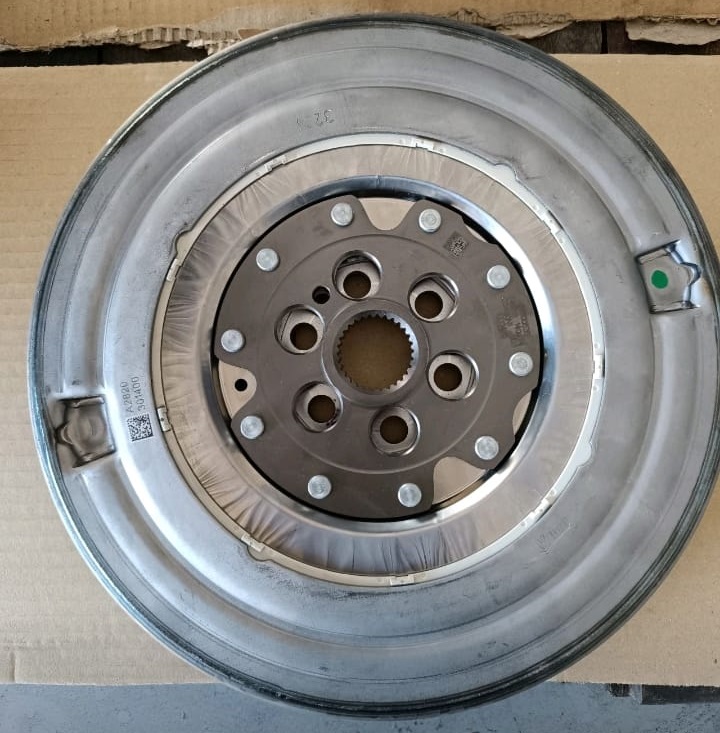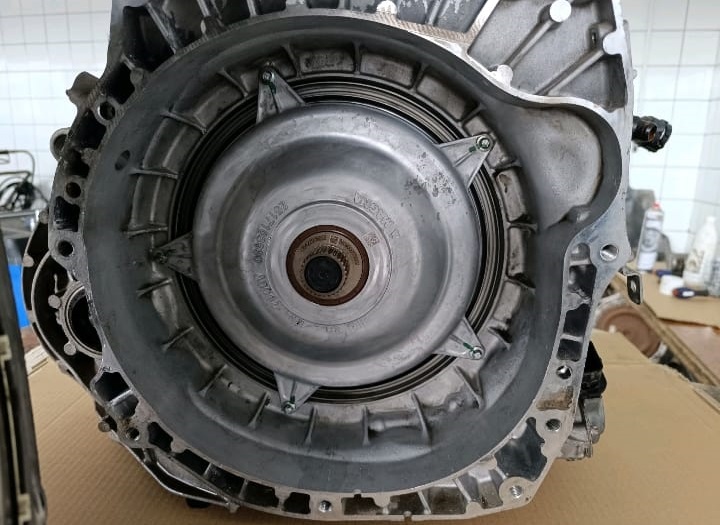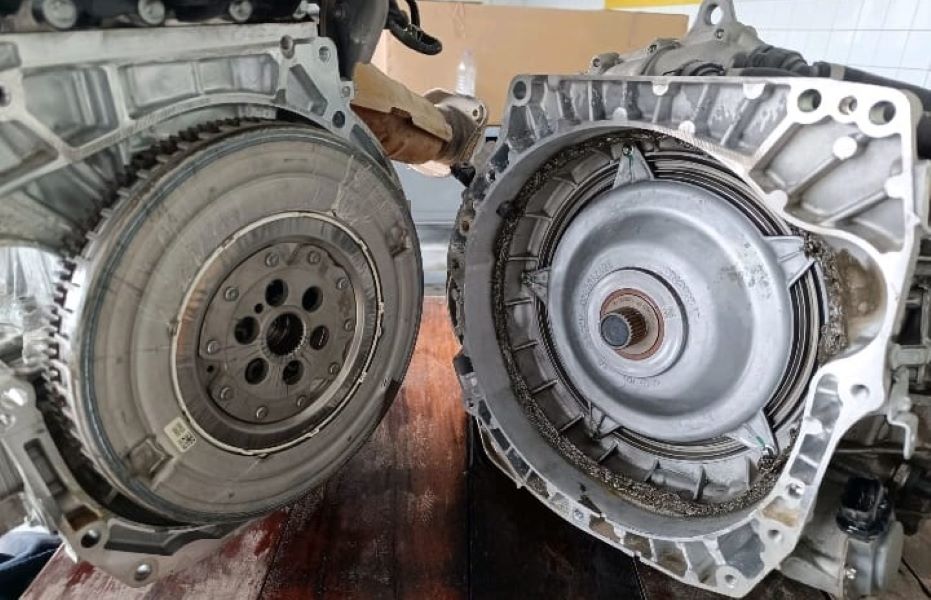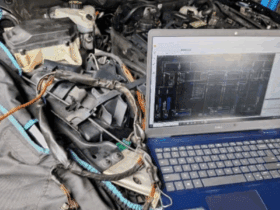Table of Contents
Case Study: Engine Vibration in a Mercedes-Benz CLA W118 (M282 Engine)
When a Mercedes engine starts vibrating, most drivers dismiss it as a small issue until it worsens into a costly drivetrain failure. This real-world case study from a Mercedes-Benz CLA W118 equipped with the M282 engine shows how a minor vibration complaint led to the discovery of a failed dual mass flywheel (DMF) that caused gearbox contamination.
This diagnosis not only restored smooth operation but also prevented a potential transmission failure.
For more real repair cases and system-level diagnostics, explore our in-depth hub:
Mercedes Check Engine Light: Complete Troubleshooting Hub
Customer Complaint: Unusual Engine Vibration
A Mercedes-Benz CLA owner brought the vehicle into the workshop after noticing a persistent vibration during idle and acceleration.
Initially, the issue seemed minor but the technician’s experience suggested that vibrations could be an early sign of a mechanical imbalance or internal drivetrain fault.
Step 1: Initial Inspection and Preliminary Tests
The diagnostic approach began with common checks that could cause vibrations in the M282 engine:
- – Engine Mounts: Visual inspection revealed no cracks or collapse.
- – Ignition System: No misfire faults or irregular firing patterns were present.
- – Fault Code Scan: A full system check using Mercedes XENTRY Diagnosis returned no active or stored DTCs related to the powertrain.
With no electronic faults present, attention turned to the drivetrain and flywheel area, where a visual clue changed the entire direction of the inspection grease leakage around the bell housing.
Step 2: Discovering the Root Cause , A Damaged Dual Mass Flywheel
Upon partial disassembly, the technician found that the dual mass flywheel casing was punctured, leading to grease loss and contamination of the gearbox with metal debris and lubricant residue.
This failure eliminated the DMF’s ability to absorb torsional vibration, transmitting harsh oscillations through the crankshaft, clutch, and gearbox.
Why the DMF Failure Caused Vibration
- – The DMF acts as a vibration damper between the engine and transmission.
- – Loss of internal grease prevents proper spring damping, resulting in unfiltered engine pulses reaching the gearbox.
- – The punctured casing caused alignment issues and increased mechanical noise, worsening the vibration over time.

Step 3: Repair Procedure and Flywheel Replacement
1. Removing the Faulty Flywheel
Accessing the mounting bolts was difficult because the damaged flywheel had shifted on its axis. The technician:
- – Locked the crankshaft to stabilize rotation.
- – Used specialized Mercedes service tools to align the bolt openings.
- – Removed the damaged flywheel without further contaminating the housing.


2. Gearbox Cleaning and Decontamination
The leaked grease and metal debris required a complete gearbox cleanout:
- – Drained gearbox oil and inspected for metallic particles.
- – Flushed the bell housing using OEM-approved solvents.
- – Inspected clutch and input shaft bearings for wear.



3. Installing a New Dual Mass Flywheel
After the gearbox was cleaned, a new OEM DMF was installed with correct torque specifications.
- – The clutch and pressure plate were realigned and balanced.
- – All fasteners were replaced as per Mercedes repair standards.

4. Testing and Verification
After reassembly, the following tests were performed:
- – Idle vibration test : engine ran smoothly with no abnormal movement.
- – Road test : verified clutch operation and power delivery.
- – Post-scan : confirmed no new DTCs or drivetrain faults.
The vibration was completely eliminated, and the CLA performed as intended.
Step 4: Key Takeaways for Technicians and Owners
Minor vibrations can mask major drivetrain faults.
What started as a small vibration complaint revealed a flywheel puncture that risked total gearbox failure.
Electrical scans alone can miss mechanical faults.
No fault codes were stored; only physical inspection uncovered the cause.
Flywheel leaks lead to gearbox contamination.
A damaged DMF can spread grease into clutch and transmission assemblies requiring full cleaning before reassembly.
Timely inspection prevents high-cost failures.
Ignoring vibration symptoms can escalate into bearing damage, clutch failure, or transmission replacement.
FAQs: Engine Vibration
What is a Dual Mass Flywheel?
A Dual Mass Flywheel (DMF) is an advanced vibration-dampening component found in modern Mercedes-Benz engines like the M282. Unlike a traditional solid flywheel, the DMF consists of two separate masses connected by internal springs and grease-filled chambers. Its main purpose is to absorb engine vibrations before they reach the gearbox, resulting in smoother acceleration, quieter operation, and improved drivetrain longevity.
How Does the Dual Mass Flywheel Work?
The DMF works by isolating and absorbing engine pulsations generated during combustion.
- – The primary mass connects to the crankshaft, while the secondary mass connects to the clutch and gearbox.
- – A set of torsional springs and friction elements between these two masses absorb rotational shocks, preventing them from transferring into the transmission.
This design ensures smoother gear changes, reduces wear on the clutch components, and enhances driving comfort in both automatic and manual Mercedes-Benz models.
Why Does a Dual Mass Flywheel Fail?
Dual Mass Flywheels typically last between 100,000 and 150,000 miles, but several factors can accelerate wear and failure:
- – Grease leakage due to casing punctures, as seen in the Mercedes CLA W118 case study.
- – Overheating caused by excessive clutch slipping or aggressive driving.
- – Imbalanced engine or worn mounts, which increase rotational stress.
- – Poor maintenance or ignoring early vibration symptoms, allowing internal springs to wear out or break.
Once internal lubrication or spring tension is lost, the DMF can no longer absorb torsional vibrations, leading to noticeable engine vibration and noise.
Can You Drive with a Bad Dual Mass Flywheel?
While technically possible, driving with a failing DMF is not recommended. A damaged flywheel can cause:
- – Severe engine vibration and drivetrain noise.
- – Clutch slippage or difficulty shifting gears.
- – Transmission contamination from leaked grease and metal debris.
Continuing to drive can result in catastrophic gearbox failure. For safety and cost reasons, it’s best to inspect and replace the DMF immediately once symptoms appear.
Should You Replace or Convert to a Solid Flywheel?
When repairing a Mercedes equipped with a DMF, you have two options:
- 1. Replace with a New Dual Mass Flywheel (Recommended)
- – Maintains factory vibration damping and smoothness.
- – Ensures optimal performance for automatic or dual-clutch transmissions.
- – Preserves fuel efficiency and drivetrain longevity.
- Convert to a Solid Flywheel (Alternative)
- – More durable and less expensive to maintain.
- – Eliminates risk of grease leakage or spring failure.
- – However, it increases vibration, noise, and gearbox wear making it unsuitable for comfort-focused Mercedes models like the CLA.
For the Mercedes-Benz CLA W118, sticking with the OEM Dual Mass Flywheel is the best option to maintain performance and refinement.
Conclusion
In this Mercedes-Benz CLA W118 case, engine vibration wasn’t an ignition or mount issue it was the result of a damaged dual mass flywheel leaking grease into the gearbox.
Through detailed mechanical diagnostics, component testing, and professional reassembly, the issue was resolved completely.
This case reinforces why vibration complaints should never be ignored and why accurate diagnostics remain central to the Mercedes Check Engine Light: Complete Troubleshooting Hub, where electrical and mechanical insights come together to restore engine performance safely and efficiently.






Leave a Reply